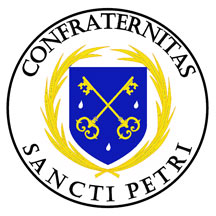
Coat of Arms of the Confraternity of St. Peter
Today, 27 February, marks the anniversary of this bloggers enrollment in the Confraternity of St. Peter.
A confraternity is, of course, a sort of organization of those united in their prayer for a particular intention and cause. In this case, "The Confraternity of St. Peter is a sodality of members who wish to unite themselves to the Priestly Fraternity of St. Peter and aid in the work of our fraternity, primarily by their prayers...Members of the Confraternity of St. Peter (CSP) pray a decade of the Rosary and the Confraternity Prayer each day for the intentions of the CSP."
The Confraternity Prayer is as follows:
"V. Remember, O Lord, Thy congregation.
R. Which Thou hast possessed from the beginning.
Let us pray.
O Lord Jesus, born to give testimony to the Truth, Thou who lovest unto the end those whom Thou hast chosen, kindly hear our prayers for our pastors.
Thou who knowest all things, knowest that they love Thee and can do all things in Thee who strengthenest them.
Sanctify them in Truth. Pour into them, we beseech Thee, the Spirit whom Thou didst give to Thy apostles, who would make them, in all things, like unto Thee.
Receive the homage of love which they offer up to Thee, who hast graciously received the threefold confession of Peter.
And so that a pure oblation may everywhere be offered without ceasing unto the Most Holy Trinity, graciously enrich their number and keep them in Thy love, who art one with the Father and the Holy Ghost, to whom be glory and honour forever.
Amen."
The website of the Confraternity can be found here: Confraternity of St. Peter

Picture credit: [By Required attribution text: by the Priestly Fraternity of Saint Peter, available from http://fssp.org., Attribution, https://commons.wikimedia.org/w/index.php?curid=5289044]
The Priestly Fraternity of St. Peter (FSSP) is an Society of Apostolic Life of Pontifical Right established in 1988 at the direction of Pope St. John Paul II for the specific purpose of preserving the traditional liturgy of the Latin Rite. This Priestly Fraternity was specifically founded to allow these venerable liturgies to remain alive in a community in full communion with, and with a deep attachment to, the Chair of St. Peter. Hence they celebrate the Mass and sacraments according to the Roman Missal of 1962; the form of the Mass authorized for use by any priests by the Apostolic Letter Motu Proprio of Pope Benedict XVI, Summorum Pontificum. Here is the website of the community: Priestly Fraternity of St. Peter (FSSP)
The FSSP celebrates Mass in 124 dioceses worldwide, and in their North American District, 96 priests administer parishes in 39 dioceses in the USA and 7 in Canada. This includes my own Archdiocese of Atlanta. Here is the website of that North American District: FSSP North American District
I am particularly blessed to belong to the parish of St. Francis de Sales, which they administer in Mableton, Georgia!
Live well!




